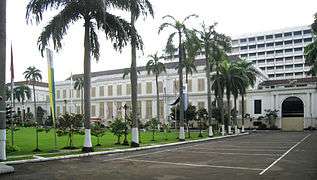Ministry of Finance (Indonesia)
| Kementerian Keuangan | |
 | |
 The A.A. Maramis Building, the headquarter of the Indonesian Ministry of Finance Building | |
| Ministry overview | |
|---|---|
| Formed | 19 August 1945 |
| Jurisdiction | Government of Indonesia |
| Headquarters |
Gedung Djuanda I Jalan Dr. Wahidin Raya No. 1 Jakarta Pusat 10710 Jakarta, Indonesia |
| Ministers responsible |
|
| Website |
kemenkeu |
Ministry of Finance is a ministry in Indonesia that hold responsibility on finance and state assets. The ministry is led by a minister and responsible to President. The motto is Nagara Dana Rakça that means guardian of state finance.
History
Colonial Period
Dutch, as Dutch East India Company, was given octrooi to print money at period of Governor General Jan Pieterszoon Coen. Since 17 century, Dutch East India Company was increasing state cash. The company raise state cash by obligation to surrender agricultural product (verplichte leverentie), restriction of agricultural production (contingenten, which increase the price) and obligation to plant strategic agricultural product such as coffee (preangerstelsel).[1]
However, British took over of Dutch East India as part of War of the Sixth Coalition and sent Stamford Raffles as Lieutenant-Governor. Stamford Raffles instituted reformation as land tax (landrent), which changed former Dutch system, to enable the society to buy British product with money. The reform was fail to introduce standardised monetary system because of lack of support from local aristocracy and inadequate society knowledge about money and tax calculation.[1]
After the Napoleonic Wars, Dutch East India was returned to Dutch from British as Anglo-Dutch Treaty of 1814. Governor General Du Bus resumed economic development and established De Javasche Bank as part of financial and payment system reform. In 1836, van den Bosch introduced forced plantation (cultuurstelsel) to produce global-favored product. Forced plantation was replacement to land tax system and had intent to introduce monetary economics to society. Forced plantation and forced labour had sufficient effect to introduce monetary economics.[1]
Government policy was shifted into liberal economics. The policy was implemented as "laissez faire, laissez passer", which economics responsibility is shifted to private sector. Department of Finance (Departement van Financien) was established to co-ordinate, develop and support financial administration. Centralized financial administration was done to make easy management of state revenue and expenditure.[1]
Second World War made the Dutch colonial government in hard position as Japanese offensive. Before the Japanese landing, President of De Javasche Bank, Dr. G.G. van Buttingha Wichers, sent gold deposit to South Africa and Australia through Cilacap. Japanese colonial government was forcing the surrender of British, Dutch and Chinese Bank and invasion money. The war made financial crisis.[1]
Early Independence
After the Japanese surrender, Indonesia declared her independence. Economics situation was very dire because of high inflation level (as circulation of De Javasche Bank money, Dutch East Indies money and Japanese Yen). Dr. Samsi, as Minister of Finance, had information that Escompto Bank at Surabaya held reserve money from Dutch Colonial Government.[1]
Organisation
- Minister of Finance
- Vice Minister of Finance
- Inspectorate General
- 8 Assistant Minister
- Secretariat General
- Center for Financial Information System and Technology
- Finance Professions Supervisory Center
- Center for Policy Analysis and Harmonization
- Center of Electronic Procurement Service
- Secretary of The Tax Court
- Government Investment Center
- Secretary of Taxation Supervisory Committee
- Educational Fund Management Institution
- Directorate General of Budget
- Directorate General of Taxes
- Directorate General of Customs and Excise
- Directorate General of Treasury
- Directorate General of Budget
- Directorate General of State Assets Management
- Directorate General of Fiscal Balance
- Directorate General of Debt and Risk Management
- Fiscal Policy Agency
- Education and Financial Training Agency
Task and Functions
Task
To run governance in terms of State finance in order to assist the President in running the State governance
Functions
Formulating, stipulating, and implementing policies in terms of budgeting, taxes, customs and excise, treasury, State assets management, fiscal balance, and budget financing and risk management; Formulating, stipulating and providing recommendations in fiscal and financial sector policies; Coordinating tasks implementation, developing, and providing administration support to entire elements of organization in the Ministry of Finance; Managing State properties/assets that are under the responsibility of Ministry of Finance; Supervising tasks implementation in the Ministry of Finance; Holding technical guidance and supervision for Minister of Finance’s affairs in regions; Implementing technical activities from central to regions; Holding education, training, and competence certification in terms of State finance; and Providing substantial support to entire elements of organization in the Ministry of Finance [2]
See also
References
- 1 2 3 4 5 6 History of Ministry of Finance Archived 9 July 2015 at the Wayback Machine. (Indonesian)
- ↑ Task and Functions (Indonesian)

